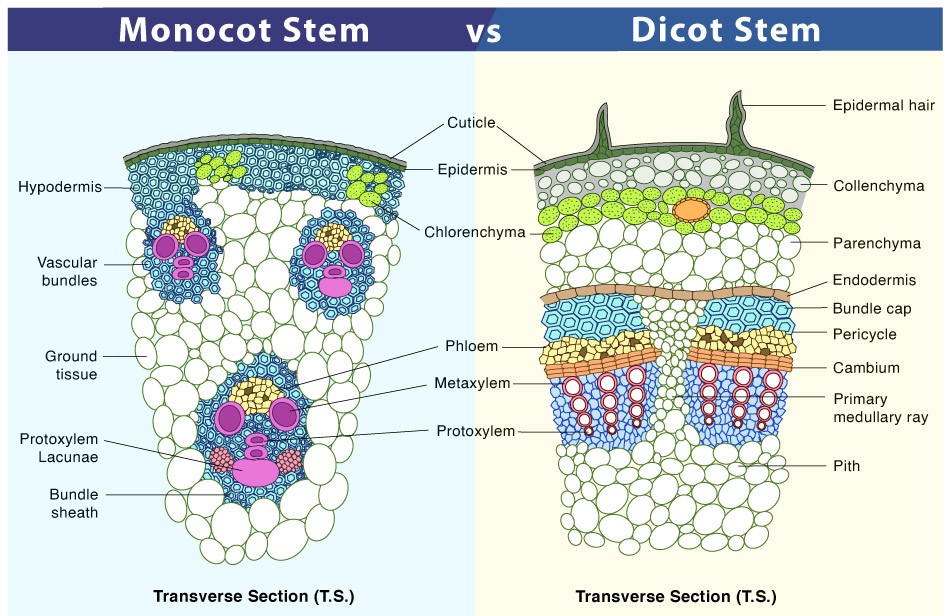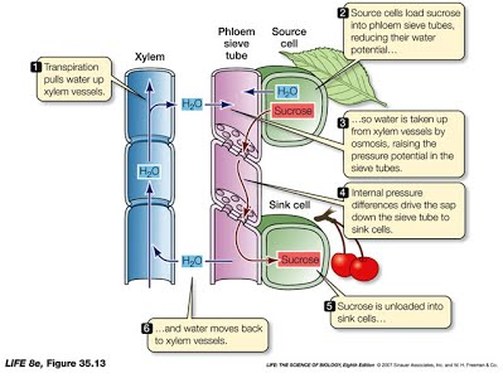Table of Contents
Phloem – Definition
Phloem tissue is one of the two types of vascular tissue in plants, along with Xylem tissue. While Xylem tissue transports water and minerals from the roots to the rest of the plant, Phloem tissue transports sugars, amino acids, hormones and other organic compounds from the leaves and other photosynthetic organs to the rest of the plant.
Structure of Phloem Tissue
Phloem tissue is composed of several different types of cells including Sieve Tube Elements, Companion Cells, Phloem Parenchyma and Phloem Fibers. Each of these cell types plays an important role in the function of Phloem tissue.

Also Check – Functions of the Xylem and Phloem
Sieve Tube Elements
Sieve Tube Elements are the main conducting cells of Phloem tissue. They are elongated cells that are arranged end-to-end to form Sieve Tubes.It function like pipelines to transport Phloem sap from source to sink tissues. Sieve Tube Elements lack nuclei and other organelles.It Allows the unobstructed flow of Phloem sap through the tube. They rely on Companion Cells for metabolic support.
Companion Cells
Companion Cells are specialized parenchyma cells that are closely associated with Sieve Tube Elements. They have dense cytoplasm, numerous mitochondria and a nucleus. Companion Cells are connected to Sieve Tube Elements via plasmodesmata.It allows for the exchange of nutrients and signals between the two cell types. Companion Cells play a critical role in supporting the metabolism and functioning of Sieve Tube Elements by providing them with energy-rich molecules, such as ATP, as well as amino acids, hormones and other essential nutrients.
Phloem Parenchyma
Phloem Parenchyma Cells are thin-walled, living cells that are interspersed between Sieve Tube Elements and Companion Cells. They function as storage cells for starch, oils and proteins, as well as provide structural support to the Phloem tissue. In some plant species, Phloem Parenchyma Cells also serve as transfer cells, which facilitate the transport of solutes between the Phloem and other tissues.
Phloem Fibers
Phloem Fibers are elongated Sclerenchyma cells that provide mechanical support to the Phloem tissue. They have thick secondary cell walls and are often found surrounding the Phloem tissue.
Function of Phloem Tissue
Transport of Sugars and other Organic Compounds
One of the primary functions of Phloem tissue is to transport sugars, amino acids, hormones and other organic compounds from source tissues (such as leaves) to sink tissues (such as roots, fruits and developing flowers). This process is known as translocation and it is essential for the growth and development of the plant.
Hormone Transport
Phloem tissue also plays a role in the transport of hormones such as Auxins and Cytokinins, which regulate plant growth and development. These hormones are synthesized in source tissues and transported via the Phloem to target tissues.
Defense against Pathogens
Phloem tissue contains specialized cells called Phloem Parenchyma Cells that can produce defense compounds such as alkaloids and Phenolics. These compounds can deter herbivores and pathogens that may damage the plant.
Signal Transmission
Phloem tissue can transmit electrical and chemical signals that coordinate plant growth and development. For example, calcium ions can be transported through the Phloem to trigger responses in target tissues.
Nutrient storage
Phloem Parenchyma Cells can store nutrients such as starch and oils, which can be used to support plant growth and development when resources are limited.
Also Check – 15 Difference between Xylem and Phloem
Types of Phloem
There are 2 types of Phloem
- Primary Phloem
- Secondary Phloem

Primary Phloem
Primary Phloem is formed during the primary growth of the plant, which occurs at the tips of stems and roots. It is formed from the apical meristem and is located in the outermost layer of the stem or root.
Primary Phloem tissue is composed of Sieve Tube Elements, Companion Cells, Phloem Fibers and Phloem Parenchyma Cells.
Sieve Tube Elements
These are the main conducting cells of Primary Phloem. They are long, narrow cells with perforated end walls called Sieve Plates that allow for the movement of sap between adjacent cells.
Companion Cells
These cells are closely associated with Sieve Tube Elements and support their metabolism and functioning.
Phloem Fibers
These are elongated cells that provide structural support to the Phloem tissue.
Phloem Parenchyma Cells
These are thin-walled cells that have various functions such as storage, secretion and support.
Secondary Phloem
Secondary Phloem tissue is formed later in the plant’s development from the vascular cambium which is a lateral meristem. It is located in the innermost layer of the bark and replaces the Primary Phloem tissue as it becomes crushed or damaged.
Secondary Phloem tissue is similar in structure to Primary Phloem tissue but with some differences.
Sieve Tube Elements
In Secondary Phloem tissue Sieve Tube Elements are shorter and wider than those in Primary Phloem tissue. They also have simpler Sieve Plates with fewer pores.
Companion Cells
Companion Cells in Secondary Phloem tissue are more specialized than those in Primary Phloem tissue and have a larger nucleus and more organelles.
Phloem Fibers
Phloem Fibers in Secondary Phloem tissue are more developed than those in Primary Phloem tissue and are responsible for providing structural support to the bark.
Phloem Parenchyma Cells
These cells in Secondary Phloem tissue are involved in the storage of organic compounds.
Phloem in Monocot and Dicots

Monocots vs. dicots: Monocots and dicots are two types of flowering plants that have different Phloem structures.
Phloem in Monocots
In monocots the Phloem tissue is located in scattered bundles throughout the stem rather than being organized into a continuous ring as in dicots. Monocots also have a specialized type of Companion Cell called transfer cells. They are involved in the transport of solutes from the Phloem to the surrounding tissue.
Phloem in Dicots
In dicots the Phloem tissue is located in a continuous ring just outside the Xylem tissue. Dicots have specialized parenchyma cells called ray cells which are involved in the lateral transport of solutes from the Phloem to the Xylem.
How does Phloem tissue work?
Phloem tissue is responsible for the transport of sugars and other organic compounds such as the amino acids and hormones from the photosynthetic organs (mostly leaves) to other parts of the plant.
Translocation
The process by which these compounds are transported is called Translocation .In Translocation the movement of material from areas of high concentration to areas of low concentration takes place.The process of translocation in Phloem tissue involves the movement of organic nutrients from source to sink. The source is the site of nutrient production, usually the leaves. The sink is the site of nutrient utilization or storage, such as the roots, developing tissues, or fruits.
The Translocation process involves several steps which are as follows –
- Loading of sugars into the Phloem – The sugars produced during photosynthesis are loaded into the Phloem tissue through specialized cells called Companion Cells. This process is called Phloem loading.
- Establishment of a gradient – The loading of sugars creates a concentration gradient between the source and sink. The concentration of sugars is higher in the source and lower in the sink.
- Movement of sugars through the Phloem – The movement of sugars through the Phloem occurs through the process of mass flow. This is driven by differences in pressure between the source and sink.
- Unloading of sugars – Once the sugars reach the sink, they are unloaded from the Phloem and used for various metabolic processes or stored for later use.

Factors affecting Translocation in Phloem Tissue
Translocation in Phloem tissue is driven by several factors. They are
- Osmotic Pressure
- Turgor Pressure
- Pressure-Flow Hypothesis.

Osmotic Pressure
- Osmotic Pressure is the pressure generated by the movement of water molecules from an area of low solute concentration to an area of high solute concentration, across a semipermeable membrane.
- In the Phloem sucrose is the most common solute and it is transported from source to sink.
- As sucrose concentration increases in the Phloem water is drawn into the Phloem resulting in an increase in Osmotic Pressure.
- This pressure gradient allows the transport of sucrose from the source to the sink.
Turgor Pressure
- Turgor Pressure is the pressure exerted by the fluid inside a plant cell against the cell wall.
- In Phloem Turgor Pressure is generated by the accumulation of water and solutes in the Sieve-Tube Elements (STE) and Companion Cells (CC).
- STE and CC are the main cells responsible for Phloem transport.
- As water moves into these cells due to Osmotic Pressure, their volume increases and Turgor Pressure builds up.
- This pressure gradient helps to push the sucrose-loaded STE from the source to the sink.
Pressure-Flow Hypothesis
- The Pressure-Flow Hypothesis is a widely accepted model for explaining Phloem transport. According to this hypothesis sucrose is actively transported into the Phloem from the source, such as leaves and it moves down the Phloem through a pressure gradient generated by Osmotic Pressure and Turgor Pressure.
- At the sink, such as roots or developing fruits, sucrose is actively transported out of the Phloem, reducing the pressure gradient, which then allows the Phloem sap to flow back towards the source.
- This process is believed to be facilitated by specialized plasmodesmata called Sieve Plates, which allow for the movement of Phloem sap between STE and CC.
Frequently asked questions on this topic
Q: What is Phloem tissue?
A: Phloem tissue is one of the two types of vascular tissue in plants, responsible for transporting sugars, amino acids, hormones and other organic compounds from the leaves and other photosynthetic organs to the rest of the plant.
Q: What are the types of components found in Phloem tissue?
A: Phloem tissue is composed of several different types of components – Sieve Tube Elements, Companion Cells, Phloem Parenchyma and Phloem Fibers.
Q: What is the function of Sieve Tube Elements?
A: Sieve Tube Elements are the main conducting cells of Phloem tissue. It is responsible for transporting Phloem sap from source to sink tissues.
Q: What is the role of Companion Cells in Phloem tissue?
A: Companion Cells are specialized parenchyma cells that are closely associated with Sieve Tube Elements providing them with metabolic support and essential nutrients.
Q: What is the function of Phloem Parenchyma cells?
A: Phloem Parenchyma Cells function as storage cells for starch, oils and proteins.It also provides structural support to the Phloem tissue.
Q: What are Phloem Fibers?
A: Phloem Fibers are elongated Sclerenchyma cells that provide mechanical support to the Phloem tissue.
Q: What are the functions of Phloem tissue?
A: The functions of Phloem tissue include the transport of sugars and other organic compounds, hormone transport, defense against pathogens, signal transmission and nutrient storage.
Q: What are the types of Phloem tissue?
A: The two types of Phloem tissue are Primary Phloem and Secondary Phloem.
Q: What is the difference between Primary and Secondary Phloem tissue?
A: Primary Phloem tissue is formed during the primary growth of the plant, while Secondary Phloem tissue is formed later in the plant’s development from the vascular cambium. Secondary Phloem tissue is located in the innermost layer of the bark and replaces the Primary Phloem tissue as it becomes crushed or damaged. There are also some differences in the structure of the cells between the two types of tissue.

5 Comments on “Phloem – Definition, Structure, Function, Types and How does Phloem tissue work”